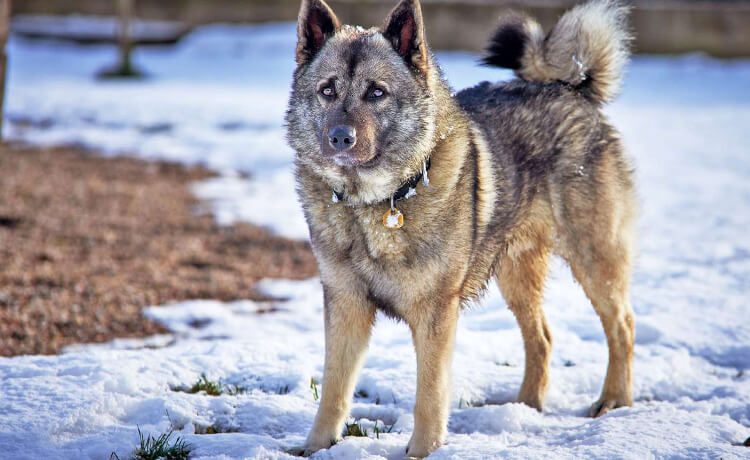
Norwegian Elkhound
The Norwegian Elkhound is a sturdy, versatile dog known for its loyalty, strength, and independent nature. A breed with a long history, the Norwegian Elkhound has been a working dog for centuries, originally bred for hunting large game, particularly elk, in the rugged Norwegian wilderness.
Appearance:
The Norwegian Elkhound has a wolf-like appearance, with a compact, well-muscled body designed for endurance and strength. Key characteristics include:
- Size: Typically stands between 19.5 to 20.5 inches tall at the shoulder.
- Weight: Ranges from 48 to 55 pounds.
- Coat: Double-coated with a thick, weather-resistant outer coat and a soft, insulating undercoat.
- Color: The coat is usually a mix of silver-gray, black, and white, with the darker color along the back and lighter shades on the belly, legs, and face.
- Distinctive Features: Their pointed ears, curled tail, and confident stance give them a fox-like appearance. Their coat also forms a ruff around the neck, which enhances their wolfish look.
Temperament:
The Norwegian Elkhound is an independent, intelligent, and strong-willed dog with a good balance of loyalty and independence. Their temperament is characterized by:
Essentials for Your Newly Adopted Pet
Welcoming a shelter pet into your life is a beautiful journey. Here are some handpicked items to help your new friend feel safe, loved, and right at home:
- Loyal and Protective: They are devoted to their families and are known to be good watchdogs, alerting their owners to any intruders.
- Friendly and Affectionate: They are generally good with children and get along well with other dogs, but they may be reserved with strangers.
- Energetic and Playful: These dogs are lively and enjoy outdoor activities, particularly running and playing.
- Independent Nature: Due to their history as independent hunters, they may be a bit stubborn and require consistent training.
Exercise Needs:
As an active and robust breed, the Norwegian Elkhound has moderate to high exercise requirements. They were bred to work in tough conditions, so they thrive in an environment where they can burn off energy. Ideal activities include:
- Daily walks: At least 45 minutes to an hour of exercise is necessary to keep them fit.
- Hiking and running: Norwegian Elkhounds love the outdoors and enjoy activities like hiking or running in a secure area.
- Interactive play: Games like fetch, tug-of-war, or agility exercises provide both mental and physical stimulation.
Health:
The Norwegian Elkhound is generally a healthy breed but may be prone to certain health conditions:
- Hip Dysplasia: As with many medium to large breeds, hip dysplasia can be a concern.
- Progressive Retinal Atrophy (PRA): A degenerative eye disease that can lead to blindness in older dogs.
- Autoimmune Conditions: They can be susceptible to autoimmune disorders, though these are not common.
- Bloat (Gastric Dilatation-Volvulus): Like many deep-chested breeds, they may be at risk of bloat, so feeding and exercise schedules should be carefully managed.
The average lifespan of a Norwegian Elkhound is 12 to 15 years.
History and Origin:
The Norwegian Elkhound's origins date back over 6,000 years. The breed was developed in Norway to hunt large game like moose and elk, using its keen nose and endurance to track and corner the prey. The breed was highly valued by the Vikings, who used Elkhounds for their hunting expeditions. The Elkhound is still used in some parts of Norway for hunting, but today, they are primarily companions and family pets.
Grooming:
The Norwegian Elkhound has moderate grooming needs due to its thick double coat:
- Regular brushing: They shed heavily, especially during seasonal changes. Brushing 2-3 times per week helps manage loose hair and keep their coat healthy.
- Bathing: Occasional baths are necessary, especially if they get dirty from outdoor activities.
- Nail trimming: Regular nail trimming is essential to prevent overgrowth.
- Ear care: Check and clean their ears regularly to prevent infections.
Ideal Home:
The Norwegian Elkhound is best suited for active families or individuals who can provide plenty of exercise and attention. Ideal living situations include:
- Active households: Elkhounds are energetic and thrive in homes with space for outdoor activities.
- Homes with a secure yard: Given their hunting instincts, a fenced-in yard is important to keep them safe and contained.
- Other pets: They are generally good with other dogs, though their strong prey drive means they may chase smaller animals, such as cats or rabbits.
Fun Facts:
- The Norwegian Elkhound is often associated with Norse mythology, where it was considered a symbol of strength and courage.
- They are known for their distinctive "bark" or "yodel," which they use to communicate with their owners or alert them to something unusual.
- Despite their wolf-like appearance, they are affectionate and gentle with their families.
- The breed’s excellent sense of smell and stamina make them superb hunters, even in harsh weather conditions.
Conclusion:
The Norwegian Elkhound is a proud, resilient, and intelligent breed that thrives on companionship, exercise, and stimulation. They are well-suited for active families or individuals who enjoy outdoor activities and can provide consistent training. Their friendly demeanor, combined with their protective instincts, makes them excellent family pets and loyal companions.
Affiliate Products
